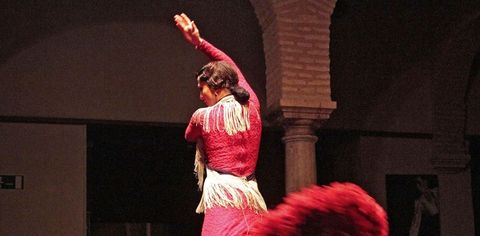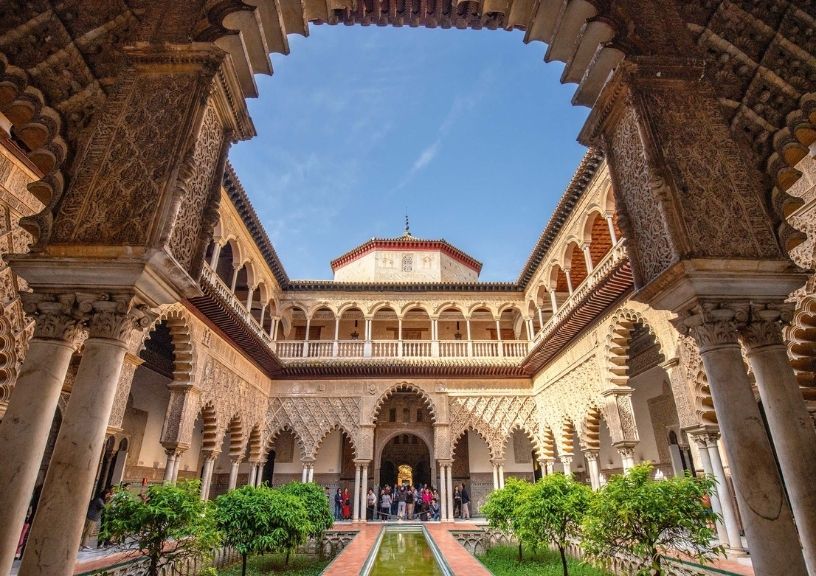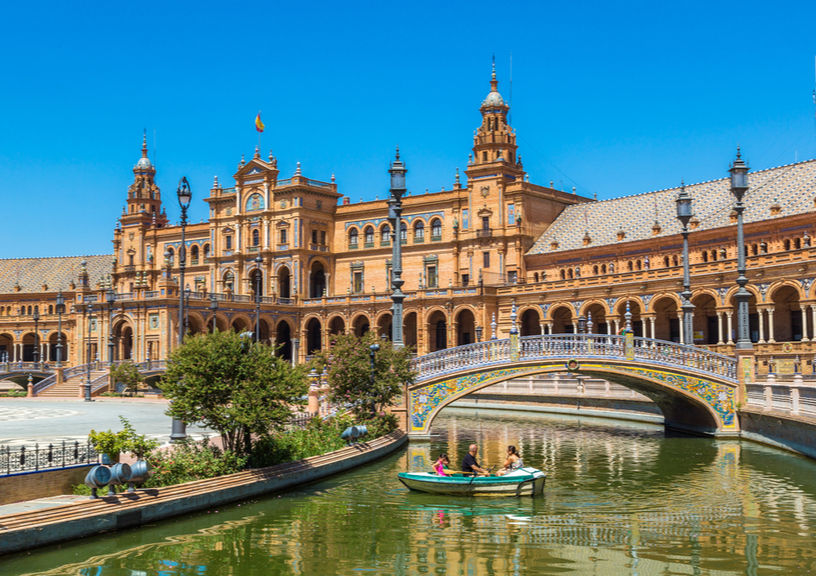
Despite being the capital of the Andalusian region, Seville retains an old-world charm with its abundant antiquity, artsy alleys, open-air cafes, and flamenco performances. By Pranjali Bhonde
A dancer in a long red dress stands alone in the darkness. The keening voice of a cantaora (singer) fills the air. “A la mare de mi alma (To the sea of my soul)”, she intones. The dancer’s arms flutter as if awakened by the mournful singing. Her feet move slightly before turning around in one swift motion. Another dancer joins in, wearing a striking yellow dress and a mantón (a type of fringed shawl), and hair done up with a peineta (an ornamental comb) and flowers. The cantaora accompanies their dance with songs, exhortations, and palmas, the rhythmic clapping of hands between beats. The movements portray different styles of flamenco: from alegrías to tarantos and the most popular bulerias. I’m in Seville—regarded as the birthplace of flamenco—seated inside a cave at Museo del Baile Flamenco, sipping sangria and trying to keep pace with the mesmerising footwork of the Spanish dance unfolding in front of me.
Exploring Seville and it’s charm
Located in the Santa Cruz neighbourhood, the museum not only showcases the history of flamenco but also hosts performances directed by Cristina Hoyos, a world-renowned flamenco dancer and actor born in Seville. The first floor of the museum features an old-style dressing room, where costumes and memorabilia are exhibited, along with some treasures from Hoyos’s screen performances. For instance, the knife from a famous fight scene in the Carlos Saura screen adaptation of Bodas de Sangre (Blood Wedding) is the centrepiece among the costumes and props. The artist’s dressing table has hats, shawls, castanets, and fans on display. The second floor is dedicated to flamenco’s influence on art, which is showcased through paintings, drawings, and sculptures made by national and international artists. The ground floor of the museum harbours a store, where I shop for curios—fridge magnets, a pack of flamenco playing cards, and a floral pericón (Spanish hand fan) decorated with laces.
On my way back to the hotel, I pass by the former Jewish quarter. These houses famously flaunted olive-oil millstones, their number indicating the wealth of each household. Although the millstones are still here, the Jews aren’t. In the 14th century, they were asked to convert to Christianity. Those who didn’t were driven out of the city.

The Santa Cruz neighbourhood is a maze of narrow streets and alleys flanked by pretty houses coloured in white and yellow. Some of the city’s most magnificent buildings are found here, and they form the legacy of the Roman Empire, which ruled Seville for over six centuries. One of them is the Real Alcázar de Sevilla, or the Royal Alcázar, the oldest royal palace still in use in Europe. Together with the Seville Cathedral and the Archivo de Indias, it forms a gigantic complex that is recognised as a UNESCO World Heritage Site. Its imposing iron gates seem to penetrate the sky and make the palace look like an impenetrable fortress. Rows of neatly lined shrubs and orange trees lead me to the palace.

It is a fine example of Mudejar construction, characterised by geometrical designs that are distinctly Islamic. At its centre is the Ambassadors’ Hall, which features a fabulously gilded dome. The main courtyard, Patio De La Doncellas, features a reflecting pool and a sunken garden. Not too far away, another water body called Mercury’s Pool is adorned with frescoes, stonework, and a water cascade feature. Behind the cascade is the Italian grotto gallery, which stands out for its use of volcanic sea rock. It’s no wonder that the Royal Alcázar was chosen as a filming location for the epic HBO series Game of Thrones. It lent its bewitching setting to the Water Gardens in the fictional city of Sunspear, seat of House Martell and capital of Dorne.

Another fine specimen of Mudejar architecture is the Cathedral de Seville, which was built on the site of a grand mosque that was erected by the Moors in the 12th century. At first, the mosque itself was Christianised by the Catholic monarch King Ferdinand III, who wrested control of Seville from the Moors in 1248. Eventually, in the 15th century, the mosque was razed to the ground and the current Cathedral built in its place over a century. The violent upheaval notwithstanding, I am awestruck by its flying buttresses and the Gothic embellishments that adorn its exterior. Inside the gigantic complex, there are 80 chapels but the main chapel, Capital Mayor, stands out for its altar—said to be the largest in the world. Another big draw of the Cathedral is that it bears the remains of Christopher Columbus. In one corner of the church, the explorer’s tomb is carried by four noblemen, each one representing the four kingdoms of Spain. One of them has pomegranates on his robe symbolising Granada. The one with chains on his robe represents the Kingdom of Navarre, while another with bats on his crown represents the Kingdom of Aragon. The one with castles on his robe and crown represents the Kingdom of Castile. Adjacent to the Cathedral is a bell tower called Giralda, which was originally built as a minaret of the mosque that stood here. It is one of the few structures retained from the original Muslim monument.

Pretty cafes dot the cobbled street outside the Cathedral. I stop by a tapas bar for food and drinks. Spanish music and wine flow interminably. I polish off a plate of salmon, washing it down with sangria. The waiter nudges me to try an orange marmalade pudding called Flan de Naranja, and it bowls me over with its mousse-like texture. On my way back to the hotel, I amble along Calle de las Sierpes (Street of the Snakes) for some retail therapy. Cafes and sweet shops lend the street a relaxed vibe. Eating gelato has always been a part of Spanish tradition, so I indulge in dollops of raspberry and lemon gelato, which offer a welcome respite from the Seville heat
Seville is not only famous for its historic monuments, but also for its larger-than-life buildings and squares, like the Plaza de España that was built in 1928 for the Ibero-American Exposition. I marvel at its lavish semi-circular countenance from inside. As I step into the corridor, I am greeted by a guitarist serenading tourists with sweet tunes. A few metres ahead, in the porticoed gallery, flamenco dancers regale passers-by with foot taps, slaps to the thighs, and sharp turns. All along the circumference of the building are benches adorned with bright and colourful azulejos, tiles typical to the Andalusian region. The benches make for the perfect Instagrammable spots. To make my experience even more memorable, I rent a boat and set sail on the canal that runs along the facade.
It’s almost evening by the time I’m done sightseeing. The setting sun turns everything a burnished orange, and I realise that two days in Seville have gone by as quickly as one of the city’s hypnotic flamenco dances.
Getting There
Air France and Lufthansa operate flights from Mumbai to Seville.
Stay
Hotel Murillo (doubles from INR 12,601) is located in the charming Santa Cruz neighbourhood. This historic hotel has a rooftop terrace and seasonal bar overlooking the city and is located a three-minute walk away from Seville Cathedral, Real Alcázar de Sevilla, and other popular sites. There is a wide range of restaurants within a five-minute walking radius of the hotel.










